3COM Link 1000 User Manual
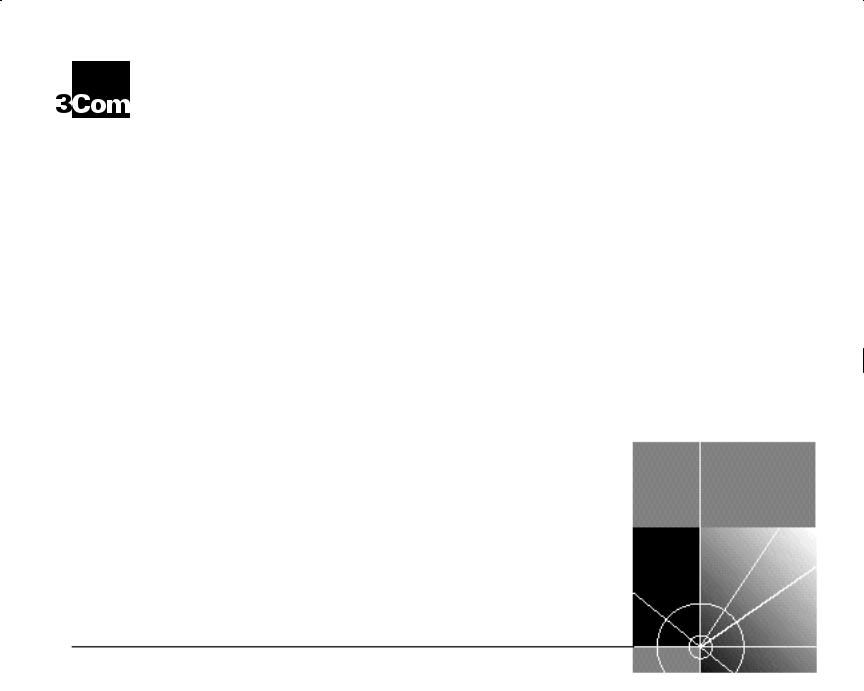
|
SuperStack® II Switch 1000 |
® |
User Guide |
Agent Software Version 3.1
http://www.3com.com/
Document No. DUA1690-0AAA05
Published June 1997

3Com Corporation ■ 5400 Bayfront Plaza ■ Santa Clara, California ■ 95052-8145
Copyright © 3Com Ireland, 1997. All rights reserved. No part of this documentation may be reproduced in any form or by any means or used to make any derivative work (such as translation, transformation, or adaptation) without permission from 3Com Ireland.
3Com Ireland reserves the right to revise this documentation and to make changes in content from time to time without obligation on the part of 3Com Ireland to provide notification of such revision or change.
3Com Ireland provides this documentation without warranty of any kind, either implied or expressed, including, but not limited to, the implied warranties of merchantability and fitness for a particular purpose. 3Com may make improvements or changes in the product(s) and/or the program(s) described in this documentation at any time.
UNITED STATES GOVERNMENT LEGENDS:
If you are a United States government agency, then this documentation and the software described herein are provided to you subject to the following restricted rights:
For units of the Department of Defense:
Restricted Rights Legend: Use, duplication, or disclosure by the Government is subject to restrictions as set forth in subparagraph (c) (1) (ii) for Restricted Rights in Technical Data and Computer Software Clause at 48 C.F.R. 52.227-7013. 3Com Ireland, c/o 3Com Limited, 3Com Centre, Boundary Way, Hemel Hempstead, Herts, HP2 7YU, United Kingdom.
For civilian agencies:
Restricted Rights Legend: Use, reproduction, or disclosure is subject to restrictions set forth in subparagraph (a) through (d) of the Commercial Computer Software - Restricted Rights Clause at 48 C.F.R. 52.227-19 and the limitations set forth in 3Com Corporation’s standard commercial agreement for the software. Unpublished rights reserved under the copyright laws of the United States.
If there is any software on removable media described in this documentation, it is furnished under a license agreement included with the product as a separate document, in the hard copy documentation, or on the removable media in a directory file named LICENSE.TXT. If you are unable to locate a copy, please contact 3Com and a copy will be provided to you.
Unless otherwise indicated, 3Com registered trademarks are registered in the United States and may or may not be registered in other countries.
3Com, AccessBuilder, Boundary Routing, CardFacts, LanScanner, LinkBuilder, NETBuilder, NETBuilder II, NetFacts, Parallel Tasking, ViewBuilder, EtherDisk, EtherLink, EtherLink Plus, EtherLink II, SmartAgent, SuperStack, TokenLink, TokenLink Plus, TokenDisk and Transcend are registered trademarks of 3Com Corporation. 3TECH, CacheCard, FDDILink, FMS and NetProbe are trademarks of 3Com Corporation. 3ComFacts is a service mark of 3Com Corporation.
Other brand and product names may be registered trademarks or trademarks of their respective holders.
3Com Environmental Statement
It is 3Com’s policy to be environmentally friendly in all its operations. This manual is printed on paper that comes from European sustainable, managed, forests. The production process for making the pulp has a reduced AOX level (adsorbable organic halogen) resulting in elemental chlorine free paper.
The paper is fully biodegradeable and recyclable.

CONTENTS
|
|
|
Switch 1000 on Your Network 1-6 |
|
|
ABOUT THIS GUIDE |
|
||
|
|
|
Server Connections 1-6 |
|
|
|
|
|
|
|
Introduction 1 |
|
|
Network Configuration Examples 1-6 |
|
How to Use This Guide 1 |
|
|
Network Segmentation I 1-7 |
|
Conventions 2 |
|
|
Network Segmentation II 1-8 |
|
Related Documentation 2 |
|
|
Desktop Switching 1-9 |
|
|
|
Unit Overview — Front 1-10 |
|
1 |
GETTING STARTED |
|
|
10BASE-T Ports 1-11 |
|
About the Switch 1000 1-1 |
|
|
100BASE-TX Port 1-11 |
|
|
|
LEDs 1-11 |
|
|
Summary of Features 1-1 |
|
|
|
|
|
Unit Overview — Rear 1-12 |
||
|
Port Connections 1-2 |
|
||
|
|
|
Power Socket 1-13 |
|
|
10BASE-T Ports 1-2 |
|
|
|
|
|
|
Unit Serial Number 1-13 |
|
|
100BASE-TX Port 1-2 |
|
|
|
|
|
|
Redundant Power System Socket 1-13 |
|
|
Plug-in Module 1-2 |
|
|
|
|
|
|
Reset Button 1-13 |
|
|
Transceiver Module 1-2 |
|
|
|
|
|
|
Console Port 1-13 |
|
|
Backbone Port 1-2 |
|
|
|
|
|
|
Plug-in Module Slot 1-13 |
|
|
Switch Operation and Features 1-3 |
|
|
|
|
|
|
Transceiver Module Slot 1-13 |
|
|
How Does the Switch Compare to a Bridge? 1-3 |
|
|
|
|
|
|
Ethernet Address 1-13 |
|
|
Forwarding of Packets 1-3 |
|
|
|
|
|
Unit Defaults 1-14 |
||
|
Intelligent Flow Management 1-4 |
|
||
|
|
Managing the Switch 1000 1-14 |
||
|
Full Duplex 1-4 |
|
||
|
|
Quick Start For SNMP Users 1-15 |
||
|
Security 1-5 |
|
||
|
|
|
Entering an IP Address for the Switch 1-15 |
|
|
Resilient Links 1-5 |
|
|
|
|
|
|
|
|
|
Virtual LANs 1-5 |
2 |
|
|
|
INSTALLATION AND SETUP |
|||
|
Spanning Tree Protocol 1-5 |
|||
|
PACE 1-6 |
|
Following Safety Information 2-1 |
|
|
|
|
Positioning the Switch 1000 2-1 |
|

Configuration Rules for Fast Ethernet 2-2 Configuration Rules with Full Duplex 2-2 Installing the Switch 1000 2-4
Rack Mounting 2-4
Stacking the Switch and Other Units 2-4 Wall Mounting 2-5
Powering-up the Switch 2-6
Connecting a Redundant Power System (RPS) 2-6 Connecting Equipment to the Console Port 2-7
Connecting a VT100 Terminal 2-7 Connecting a VT100 Terminal Emulator 2-7 Connecting a Workstation Running SLIP 2-8
3 SETTING UP FOR MANAGEMENT
Methods of Managing the Switch 1000 3-1 Using the VT100 Management Interface 3-1 Using Telnet 3-2
Managing Over The Network 3-2 IP Addresses 3-2
Obtaining a Registered IP Address 3-3 Navigating the VT100 Screens 3-4
Screen Conventions 3-4
Keyboard Shortcuts 3-5
Correcting Text Entry 3-5
Setting Up the Switch for Management 3-6 Logging On 3-7
After Logging On 3-8
Switch Management Setup 3-9 Logging Off 3-12
Auto Logout 3-12
4 MANAGING THE SWITCH 1000
Setting Up Users 4-2 Creating a New User 4-3 Deleting a User 4-4 Editing User Details 4-5
Assigning Local Security 4-6
Choosing a Switch Management Level 4-7 Setting Up the Switch Unit 4-9
Setting Up the Switch Ports 4-12
Setting Up the Switch Database (SDB) 4-16 The Database View 4-17
Searching the Switch Database 4-18 By MAC Address 4-18
By Port 4-18
Adding an Entry into the SDB 4-18 Deleting an Entry from the SDB 4-18 Specifying that an Entry is Permanent 4-18
Setting Up Resilient Links 4-19 Configuring Resilient Links 4-20 Creating a Resilient Link Pair 4-21 Deleting a Resilient Link 4-21 Viewing the Resilient Setup 4-22
Setting Up Traps 4-24
Setting Up the Console Port 4-25 Resetting the Switch 4-27 Initializing the Switch 4-28 Upgrading Software 4-29
5 ADVANCED MANAGEMENT
Virtual LANs (VLANs) 5-1
What are VLANs? 5-1
Benefits of VLANs 5-1

How VLANs Ease Change and Movement 5-2 |
|
|
Enabling STP on the Switch 5-17 |
How VLANs Control Broadcast Traffic 5-2 |
|
|
Configuring STP on the Switch 5-18 |
How VLANs Provide Extra Security 5-2 |
|
|
Configuring the STP Parameters of VLANs 5-18 |
An Example 5-2 |
|
|
Configuring the STP Parameters of Ports 5-20 |
VLANs and the Switch 5-3 |
|
RMON 5-22 |
|
The Default VLAN and Moving Ports From the Default |
|
|
What is RMON? 5-22 |
VLAN 5-3 |
|
|
About the RMON Groups 5-23 |
Connecting VLANs to a Router 5-3 |
|
|
|
|
|
Statistics 5-23 |
|
Connecting Common VLANs Between Switch Units |
|
|
|
|
|
History 5-23 |
|
5-3 |
|
|
|
|
|
Alarms 5-23 |
|
Using AutoSelect VLAN Mode 5-3 |
|
|
|
|
|
Hosts 5-23 |
|
Using Non-routable Protocols 5-5 |
|
|
|
|
|
Hosts Top N 5-23 |
|
Using Unique MAC Addresses 5-5 |
|
|
|
|
|
Matrix 5-24 |
|
Extending VLANs into an ATM Network 5-5 |
|
|
|
|
|
Filter 5-24 |
|
VLAN Configurations 5-5 |
|
|
|
|
|
Capture 5-24 |
|
Example 1 5-5 |
|
|
|
|
|
Events 5-24 |
|
Example 2 5-6 |
|
|
|
|
|
Benefits of RMON 5-25 |
|
Example 3 5-7 |
|
|
|
|
|
How RMON Improves Your Efficiency 5-25 |
|
Setting Up VLANs on the Switch 5-8 |
|
|
|
|
|
How RMON Allows Proactive Management 5-25 |
|
Assigning a Port to a VLAN When Using Port VLAN |
|
|
|
|
|
How RMON Reduces the Traffic Load 5-25 |
|
Mode 5-10 |
|
|
|
|
|
RMON and the Switch 5-26 |
|
Specifying a Backbone Port 5-10 |
|
|
|
|
|
RMON Features of the Switch 5-26 |
|
Specifying that a Port is a VLT Port 5-10 |
|
|
|
|
|
About Alarm Actions 5-28 |
|
Setting Up VLANs Using AutoSelect VLAN Mode 5-11 |
|
|
|
|
|
About Default Alarm Settings 5-29 |
|
Specifying Information About the VLAN Server 5-11 |
|
|
|
|
|
About the Audit Log 5-29 |
|
Specifying AutoSelect VLAN Mode 5-11 |
|
|
|
|
|
|
|
Spanning Tree Protocol 5-12 |
6 |
|
|
What is STP? 5-12 |
STATUS MONITORING AND STATISTICS |
||
How STP Works 5-14 |
|
Summary Statistics 6-2 |
|
STP Initialization 5-14 |
|
Port Statistics 6-3 |
|
|
|
||
STP Stabilization 5-14 |
Port Traffic Statistics 6-4 |
|
STP Reconfiguration 5-14 |
||
Port Error Analysis 6-6 |
||
An Example 5-15 |
||
Status Monitoring 6-8 |
||
STP Configurations 5-16 |
||
|

Fault Log 6-9
Remote Polling 6-10
A SAFETY INFORMATION
Important Safety Information A-1
Power Supply and Fuse A-3
Sockets for Redundant Power System (RPS) A-3 RJ45 Ports A-3
Fiber Ports A-3
L’information de Sécurité Importante A-4 La Source de Courant et Le Fusible A-5 Socle Pour Alimentation Multiple A-5 Les Ports RJ45 A-6
Les Ports Fibre A-6
Wichtige Sicherheitsinformationen A-7 Stromversorgung und Sicherung A-8
Steckdose für Redundant Power System (RPS) A-8 RJ45 Anschlußen A-8
Glasfaser Anschlußen A-8
BSCREEN ACCESS RIGHTS
CTROUBLE-SHOOTING
LEDs C-1
Using the VT100 Interface C-2
Using the Switch C-3
D PIN-OUTS
Null Modem Cable D-1
PC-AT Serial Cable D-1
Modem Cable D-2
RJ45 Pin Assignments D-2
ESWITCH 1000 TECHNICAL SPECIFICATIONS
FTECHNICAL SUPPORT
Online Technical Services F-1 World Wide Web Site F-1
3Com Bulletin Board Service F-1 Access by Analog Modem F-1 Access by Digital Modem F-2
3ComFacts Automated Fax Service F-2 3ComForum on CompuServe Online Service F-2
Support from Your Network Supplier F-3 Support from 3Com F-3
Returning Products for Repair F-4
GLOSSARY
INDEX
3COM CORPORATION LIMITED WARRANTY
ELECTRO-MAGNETIC COMPATIBILITY

ABOUT THIS GUIDE
About This Guide provides an overview of this guide, describes the guide conventions, tells you where to look for specific information and lists other publications that may be useful.
Introduction
This guide provides the information you need to install and configure the SuperStack® II Switch 1000 24 Port (3C16900A) and the SuperStack II Switch 1000 12 Port (3C16901A) with v3.1 agent software. The functionality of both units is identical, although the local management screens reflect the different number of ports. Where appropriate, these differences are noted.
The guide is intended for use by network administrators who are responsible for installing and setting up network equipment; consequently, it assumes a basic working knowledge of Local Area Networks.
If the information in the Release Notes shipped with your product differs from the information in this guide, follow the Release Notes.
Throughout this guide, the SuperStack II Switch 1000 is referred to as the Switch 1000 or Switch.
How to Use This Guide
This table shows where to find specific information in this guide.
If you are looking for... |
Turn to... |
|
|
An overview of the Switch 1000 |
Chapter 1 |
Information about installing the Switch 1000 into |
Chapter 2 |
your network |
|
Information about the methods you can use to man- |
Chapter 3 |
age the Switch 1000 |
|
Information about managing the Switch 1000 |
Chapter 4 |
Information about more advanced management fea- |
Chapter 5 |
tures; for example VLANs, Spanning Tree and RMON |
|
Information about monitoring the status of the |
Chapter 6 |
Switch 1000 |
|
Safety information |
Appendix A |
Information about the access rights for each VT100 |
Appendix B |
screen |
|
Trouble-shooting information |
Appendix C |
Information about the pin-outs relating to the Switch |
Appendix D |
1000 |
|
Information about the Technical Specifications of the |
Appendix E |
Switch 1000 |
|
Information about the Technical Support available |
Appendix F |
from 3Com |
|
|
|

2 ABOUT THIS GUIDE
Conventions
Table 1 and Table 2 list conventions that are used throughout this guide.
Table 1 Text Conventions
Convention |
Description |
|
Screen |
This typeface represents information as it |
|
displays |
appears on the screen. |
|
The words |
When you see the word “enter” in this guide, |
|
“enter” |
you must type something, and then press the |
|
and “type” |
Return or Enter key. Do not press the Return or |
|
|
Enter key when an instruction simply says |
|
|
“type.” |
|
[Key] names |
Key names appear in text in one of two ways: |
|
|
■ |
Referred to by their labels, such as “the |
|
|
Return key” or “the Escape key” |
|
■ |
Written with brackets, such as [Return] or |
|
|
[Esc]. |
|
If you must press two or more keys simulta- |
|
|
neously, the key names are linked with a plus |
|
|
sign (+). Example: |
|
|
|
Press [Ctrl]+[Alt]+[Del]. |
Menu commands |
Menu commands or button names appear in |
|
and buttons |
italics. Example: |
|
|
|
From the Help menu, select Contents. |
Words in italicized |
Italics emphasize a point or denote new terms at |
|
type |
the place where they are defined in the text. |
|
Words in |
Bold text denotes key features. |
|
bold-face type |
|
|
Table 2 |
Notice Icons |
|
Icon |
Notice Type |
Alerts you to... |
|
Information |
Important features or instructions |
|
note |
|
|
Caution |
Risk of personal injury, system damage, |
|
|
or loss of data |
|
Warning |
Risk of severe personal injury |
Related Documentation
The Switch 1000 document set includes:
■SuperStack II Switch 1000 Quick Reference Guide.
Document Number DQA1690-0AAA0x
■SuperStack II Switch 1000 Quick Installation Guide.
Document Number DIA1690-0AAA0x
■SuperStack II Switch 1000 Release Notes. Document Number DNA1690-0AAA0x
Other publications you may find useful:
■Documentation accompanying the Plug-in Modules.
■Documentation accompanying the Redundant Power System.

1 GETTING STARTED
About the Switch 1000
Part of 3Com’s SuperStack® II range of products, the Switch 1000 is designed to overcome the common problem of insufficient bandwidth for today’s growing network applications, while providing low-cost, high performance networking with little need for configuration. Use the Switch 1000 to provide your users with greater bandwidth, faster throughput and high speed links.
The SuperStack II Switch 1000 is a revision of the LinkSwitch 1000.
Summary of Features
The Switch 1000 has the following features:
■12 or 24 Ethernet 10BASE-T ports
■Fast Ethernet 100BASE-TX port
■Plug-in Module slot (Asynchronous Transfer Mode (ATM) and Fast Ethernet)
■Transceiver Module slot (10Mbps Ethernet)
■Support for up to 500 endstations, unlimited stations on backbone port
■Four forwarding modes for packets
■Intelligent Flow Management for congestion control
■Full duplex on all fixed Ethernet and Fast Ethernet ports, and Fast Ethernet Plug-in Module ports
■Security
■Resilient Links
■Support for 16 Virtual LANs (VLANs)
■Spanning Tree Protocol (STP) per VLAN
■PACE (Priority Access Control Enabled) for supporting multimedia applications over Ethernet
■3Com’s SuperStack II architecture:
■Connects to Redundant Power System
■Integrated network management
■19-inch rack or stand-alone mounting
■SmartAgent support:
■IP and IPX management over SNMP
■RMON
■Repeater and Bridge MIB
■Broadcast storm control
■Easy software upgrades
■BOOTP for automatic IP address configuration
■Local management
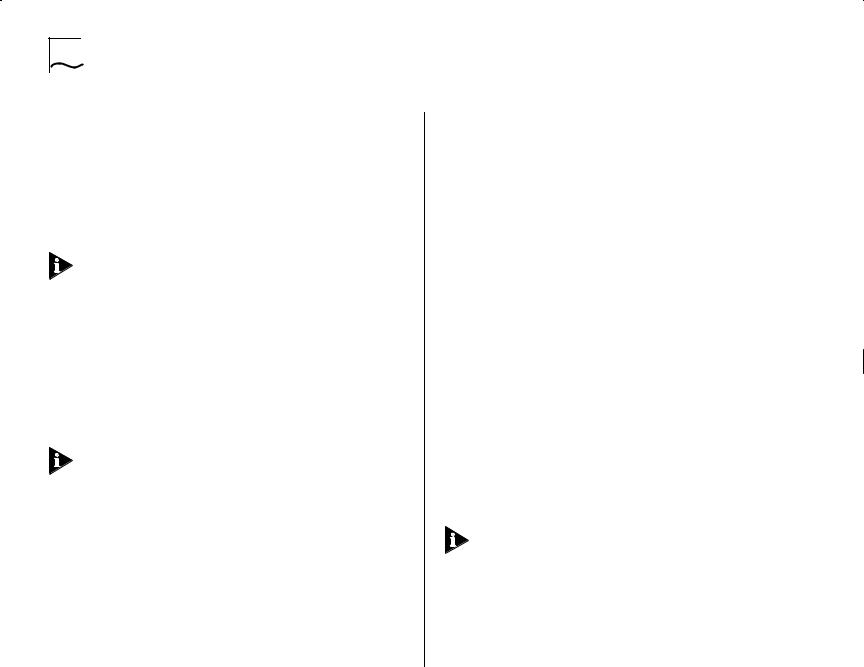
1-2 CHAPTER 1: GETTING STARTED
Port Connections
10BASE-T Ports
The Switch has 12 or 24 10BASE-T ports configured as MDIX (cross-over), which provide a full 10Mbps bandwidth to attached endstations. Maximum segment length is 100m (328ft) over grade 3, 4, or 5 twisted pair cable.
As these ports are configured as MDIX (cross-over), you need to use a cross-over cable to connect to devices whose ports are MDIX-only. Most of the 10BASE-T ports in 3Com devices are MDIX-only.
100BASE-TX Port
The Switch has a single Fast Ethernet 100BASE-TX port configured as MDIX (cross-over), which provides a 100Mbps connection to, for example, a local server. The maximum segment length is 100m (328ft) over grade 5 twisted pair cable.
As this port is configured as MDIX (cross-over), you need to use a cross-over cable to connect to devices whose ports are MDIX-only. Most of the 100BASE-TX ports in 3Com devices are MDIX-only.
Plug-in Module
A slot at the rear of the unit can take a Plug-in Module, providing an additional high-speed port. This could be used, for example, to provide a Fast Ethernet or Asynchronous Transfer Mode (ATM) backbone connection to the rest of your network.
Transceiver Module
A slot at the rear of the unit allows you to install any of the 3Com 10Mbps Ethernet Transceiver Modules. When a Transceiver Module is fitted, port 1 automatically switches to become the Transceiver Module port. The Transceiver Module can provide a 10Mbps link to the rest of your network.
Backbone Port
The Switch allows you to specify any port to be a backbone port with the following attributes:
■Frames with unknown addresses received by the Switch are forwarded to the port.
■Addresses received on the port are not stored in the Switch Database (the database which contains the device addresses received by the Switch).
A backbone port is typically used to connect the Switch to the backbone of large networks (over 500 MAC addresses). For information about how to specify a backbone port for a new or initialized Switch, refer to “Setting Up the Switch Unit” on page 4-9.
You can specify one backbone port for each VLAN defined on the Switch. For more information about how to specify a backbone port for a VLAN, refer to “Setting Up VLANs on the Switch” on page 5-8.

Switch Operation and Features
How Does the Switch Compare to a Bridge?
The table below shows how Switch 1000 operation compares to that of a conventional IEEE 802.1d bridge.
|
IEEE 802.1d Bridge |
Switch 1000 |
Address Learning |
All ports |
All ports except back- |
|
|
bone port |
Forwarding Mode |
Store and forward |
Fast Forward, Frag- |
|
|
ment Free, Store and |
|
|
forward, or Intelligent |
Operation when |
Discard packets |
Invoke Intelligent |
packet buffers full |
|
Flow Management to |
|
|
suppress transmis- |
|
|
sions at source |
Spanning Tree |
Supported |
Optional |
Action on |
Flood all ports |
Forward to backbone |
Unknown |
|
port, or forward to |
Destination |
|
all ports |
Address |
|
|
Database size |
4000 addresses |
500 addresses |
In all other ways, Switch 1000 and bridge operation is identical.
About the Switch 1000 |
1-3 |
Forwarding of Packets
The table below shows how a packet is processed when it arrives at the Switch 1000.
Packet Source |
Destination |
Action |
|
Address |
|
Any port EXCEPT back- |
Unknown |
Forward to back- |
bone (Unicast packet) |
|
bone port only, or |
|
|
forward to all ports |
|
Same port as |
Filter |
|
source address |
|
|
Another port (not |
Forward to specific |
|
backbone) |
port only |
Any port EXCEPT back- |
Not applicable |
Forward to all ports |
bone (Multi/Broadcast |
|
(including back- |
packet) |
|
bone) in the same |
|
|
VLAN as source port |
Backbone port |
Unknown |
Filter |
(Unicast packet) |
|
|
|
Known port (not |
Forward to known |
|
backbone) |
port only |
Backbone port |
Not applicable |
Forward to all ports |
(Multi/Broadcast packet) |
|
within specific VLAN |
You can configure the Switch to forward packets with an unknown destination address to all ports in the same VLAN as the source port. Refer to “Setting Up the Switch Unit” on page 4-9 for more information.
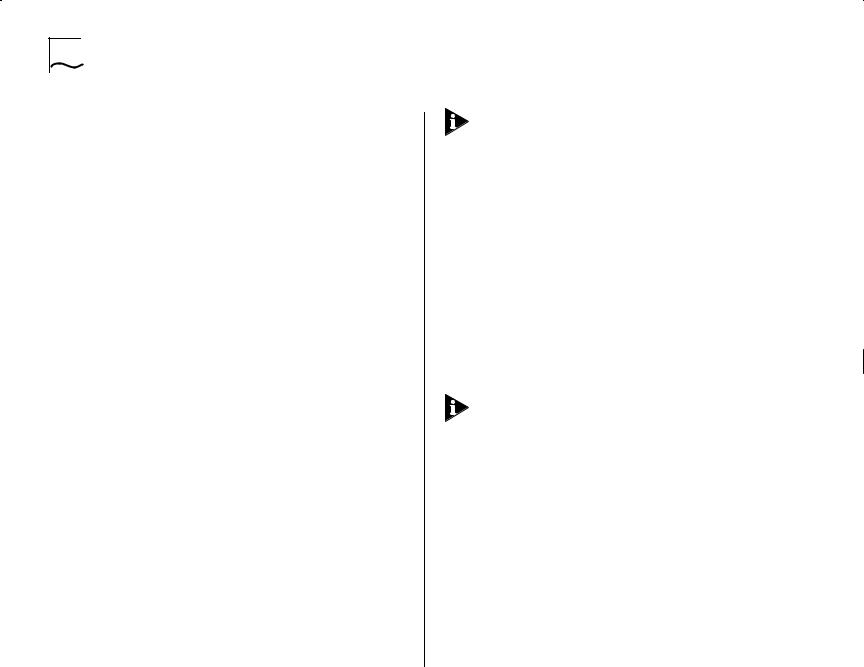
1-4 CHAPTER 1: GETTING STARTED
To best suit your networking requirements, the Switch 1000 allows you to select one of four frame forwarding modes:
■Fast Forward — Frames are forwarded as soon as the destination address is received and verified. The forwarding delay, or latency, for all frames in this mode is just 40µs, but with the lack of checking time any error frames received are propagated through the switch.
■Fragment Free — A minimum of 64 bytes of the received frame is buffered prior to the frame being forwarded. This ensures that collision fragments are not propagated through the network. The forwarding delay, or latency, for all frames in this mode is 64µs.
■Store and Forward — Received packets are buffered in their entirety prior to forwarding. This ensures that only good frames are passed to their destination. The forwarding delay for this mode varies between 64µs and 1.2ms, depending on frame length. In Store and Forward mode, latency is measured as the time between receiving the last bit of the frame and transmitting the first bit. For the Switch 1000, this is 8µs.
■Intelligent — The Switch monitors the amount of error traffic on the network and changes the forwarding mode accordingly. If the Switch detects less than 18 errors a second, it operates in Fast Forward mode. If the Switch detects 18 or more errors a second, it operates in Store and Forward mode until the number of errors a second returns to zero.
For more information about selecting forwarding modes, refer to “Setting Up the Switch Unit” on page 4-9.
Intelligent Flow Management
Intelligent Flow Management (IFM) is a system for controlling congestion on your network. Congestion can be caused by one or more devices sending traffic to an already busy port on the Switch 1000. If a port on the Switch 1000 is connected to another switch or endstation, IFM prevents packet loss and inhibits the device from generating more packets until the period of congestion ends.
IFM should be enabled on a port if it is connected to another switch, or an endstation. IFM should be disabled on a port connected to a repeater.
For more information about enabling IFM, refer to “Setting Up the Switch Ports” on page 4-12.
Full Duplex
The Switch 1000 provides full duplex support for all its fixed ports, and Fast Ethernet Plug-in Module ports. Full duplex allows frames to be transmitted and received simultaneously and, in effect, doubles the potential throughput of a link. In addition, full duplex also supports 100BASE-FX cable runs of up to 2km (6562ft).
Full duplex can be enabled on all the relevant ports, all the Fast Ethernet ports, or on individual ports. It is not supported by the Transceiver Module.
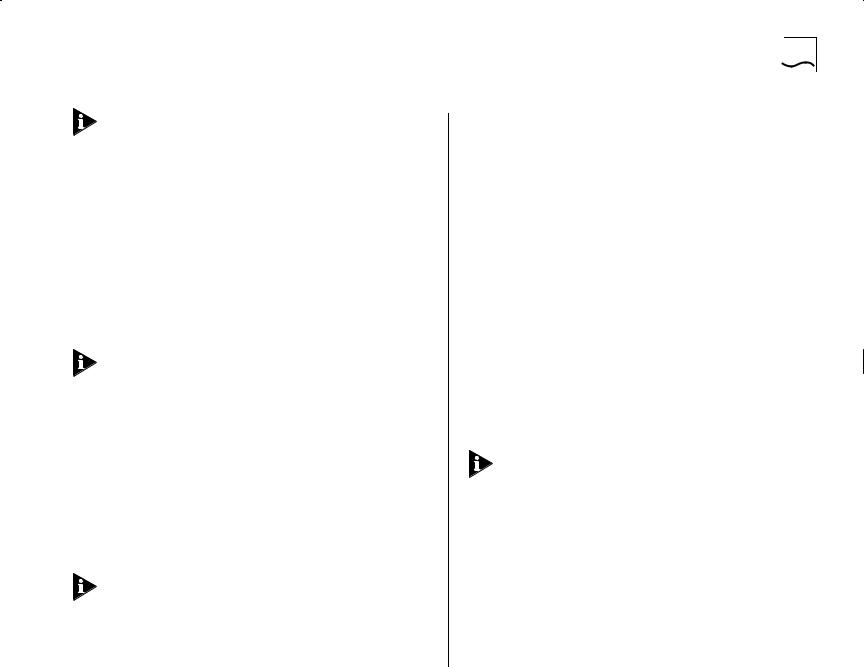
For more information about enabling full duplex, refer to “Setting Up the Switch Unit” and “Setting Up the Switch Ports” in Chapter 4.
Security
The Switch 1000 contains advanced security features which guard against users connecting unauthorized endstations to your network. When security is enabled on a port, it enters single address learning mode. In this mode, the port learns a single Ethernet address; once this is learned, the port is disabled if a different address is seen on the port. Until security is disabled, no other address can be learned.
For more information about security, refer to “Setting Up the Switch Ports” on page 4-12.
Resilient Links
The Resilient Link feature in the Switch 1000 enables you to protect critical links and prevent network downtime should those links fail.
Setting up resilience ensures that should a main communication link fail, a standby duplicate link immediately and automatically takes over the task of the main link. Each main and standby link pair is referred to as a resilient link pair.
For more information about resilient links, refer to “Setting Up Resilient Links” on page 4-19.
About the Switch 1000 |
1-5 |
Virtual LANs
The Switch 1000 has a Virtual LAN (VLAN) feature which allows you to build your network segments without being restricted by physical connections. A VLAN is defined as a group of locationand topology-independent devices that communicate as if they are on the same physical LAN. Implementing VLANs on your network has three main advantages:
■It eases the change and movement of devices on IP networks. If an endstation in VLAN 1 is moved to a port in another part of the network, you only need to specify that the new port is in VLAN 1.
■It helps to control broadcast traffic. If an endstation in VLAN 1 transmits a broadcast frame, then only VLAN 1 devices receive the frame.
■It provides extra security. Devices in VLAN 1 can only communicate with devices in VLAN 2 using a router.
For more information about setting up VLANs on the Switch, refer to “Virtual LANs (VLANs)” on page 5-1.
Spanning Tree Protocol
The Switch 1000 supports the Spanning Tree Proto- col (STP) which is a bridge-based system for providing fault tolerance on networks. STP allows you to implement parallel paths for network traffic, and ensure that:
■Redundant paths are disabled when the main paths are operational.
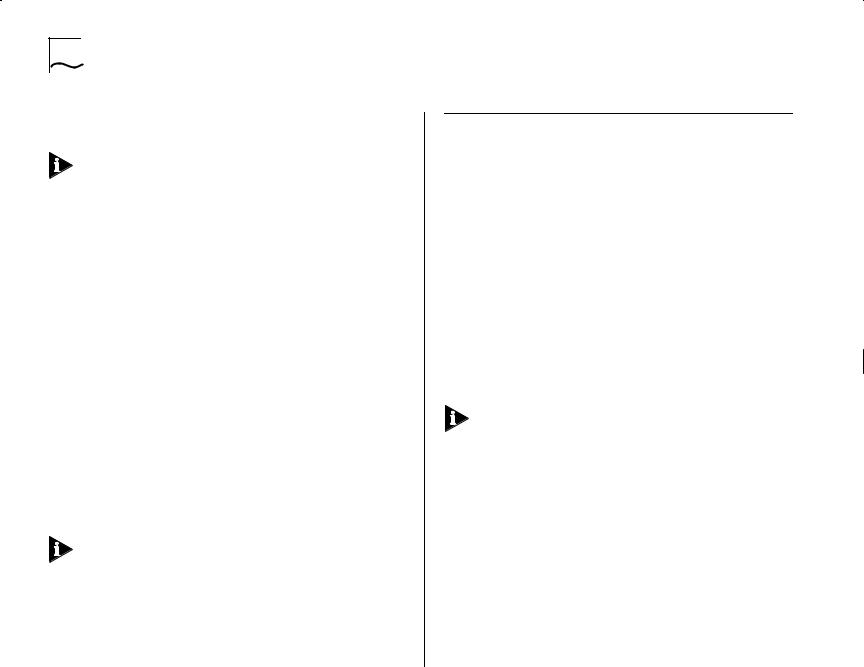
1-6 CHAPTER 1: GETTING STARTED
■Redundant paths are enabled if the main traffic paths fail.
For more information about STP, refer to “Spanning Tree Protocol” on page 5-12.
PACE
The Switch 1000 supports PACE (Priority Access Control Enabled) technology, which allows multimedia traffic to be carried over standard Ethernet and Fast Ethernet LANs. PACE provides two features:
■Implicit Class of Service — When multimedia traffic is transmitted, it is given a higher priority than other data and is therefore forwarded ahead of other data when it arrives at the Switch. The Implicit Class of Service feature minimizes latency through the Switch and protects the quality of multimedia traffic.
■Interactive Access — When two-way multimedia traffic passes over an Ethernet network, interference can occur because access to the bandwidth is unequally allocated to traffic in one direction.
The Interactive Access feature allocates the available bandwidth equally in both directions, therefore increasing the quality of the traffic.
For more information about setting up PACE on the Switch, refer to “Setting Up the Switch Unit” and “Setting Up the Switch Ports” in Chapter 4.
Switch 1000 on Your Network
Server Connections
When connecting servers to the Switch 1000, use the following rules to ensure that the Switch is operating at maximum efficiency:
■Ideally, any local server should be connected to the Switch using a 100Mbps port.
■If that is not possible, connect the local server to a dedicated 10Mbps port.
■If that is not possible and the local server is connected to a repeated segment where the traffic is mainly local to that segment, disable Intelligent Flow Management (IFM) on the port to which the repeater is connected.
If your network is running a peer-to-peer protocol (for example, Windows 95) and you have multiple endstations connected to the Switch via a repeater, we recommend that you disable IFM on the port to which the repeater is connected.
Network Configuration Examples
The following illustrations show some examples of how the Switch can be placed on your network.
Examples of how the Switch 1000 can be used in a VLAN-based network are given in Chapter 5.

Switch 1000 on Your Network |
1-7 |
Network Segmentation I
This example shows how the Switch 1000 fits into a large corporate network with a Fast Ethernet infrastructure. A Switch is positioned on each floor and servers are centralized in the basement.
Figure 1-1 The Switch 1000 in a large corporate network
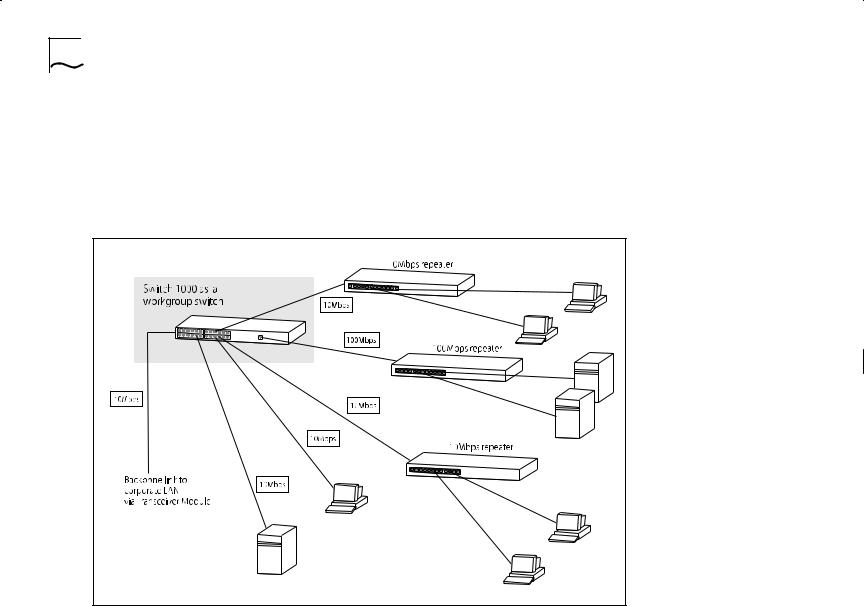
1-8 CHAPTER 1: GETTING STARTED
Network Segmentation II
This example shows the Switch 1000 in a second workgroup situation. This setup could be that of a small office within a large corporation, or part of a larger corporate network. Most of the switch ports have multiple endstations.
Figure 1-2 |
The Switch 1000 in a workgroup |
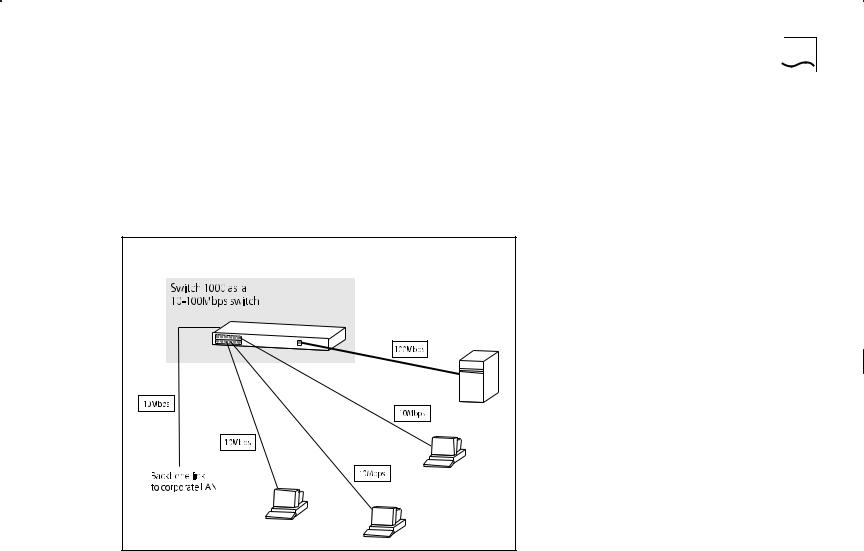
Switch 1000 on Your Network |
1-9 |
Desktop Switching
This example shows Switch 1000 used for a group of heavy-traffic users in a large corporate network. Here switching is brought to the desktop with a single endstation per switch port. A local server is connected using the 100Mbps Fast Ethernet link.
Figure 1-3 The Switch 1000 as a desktop switch

1-10 CHAPTER 1: GETTING STARTED
Unit Overview — Front
Figure 1-4 Switch 1000 front view: 3C16901A top, 3C16900A bottom

10BASE-T Ports
The Switch has 12 or 24 10BASE-T RJ45 ports configured as MDIX (cross-over), which provide a full 10Mbps bandwidth to attached endstations. The maximum segment length is 100m (328ft) over category 3, 4, or 5 UTP cable.
As these ports are configured as MDIX (cross-over), you need to use a cross-over cable to connect to devices whose ports are MDIX-only. Most of the 10BASE-T ports in 3Com devices are MDIX-only.
100BASE-TX Port
The Switch has a single Fast Ethernet 100BASE-TX RJ45 port configured as MDIX (cross-over), which provides a 100Mbps connection to, for example, a local server. The maximum segment length is 100m (328ft) over category 5 UTP or STP cable.
As this port is configured as MDIX (cross-over), you need to use a cross-over cable to connect to devices whose ports are MDIX-only. Most of the 100BASE-TX ports in 3Com devices are MDIX-only.
LEDs
The table below describes the LED behavior on the Switch. For more details about corrective action in the event of a problem, refer to “LEDs” on page C-1.
Unit Overview — Front |
1-11 |
LED |
Color |
Indicates |
|
|
|
TCVR |
Yellow |
Port 1 is a Transceiver Module fitted to the |
|
|
rear of the unit. |
Port Status LEDs |
|
|
Packet |
Yellow |
Frames are being transmitted/received on the |
|
|
port. |
Status |
Green |
Link is present; port is enabled. |
|
Green flashing |
Link is present; port is disabled. |
|
Off |
Link is not present. |
Plug-in Module Status LEDs |
||
Packet |
Yellow |
Frames are being transmitted/received on the |
|
|
Plug-in Module port. |
Status |
Green |
Link is present; port is enabled. |
|
Green flashing |
Link is present; port is disabled. |
|
Green flashing |
Refer to the “SuperStack II Switch ATM |
|
(long on, short |
OC-3c Module User Guide”. |
|
off) |
|
|
Yellow |
Plug-in Module has failed its Power On Self |
|
|
Test (if the MGMT LED is flashing yellow), or |
|
|
the agent software of the Plug-in Module is |
|
|
not installed correctly. |
|
Yellow flashing |
Plug-in Module is not recognized. |
|
Off |
Link is not present or Plug-in Module is not |
|
|
installed in the Switch. |
Unit Status LEDs |
|
|
Power |
Green |
Switch is powered-up. |
MGMT |
Green |
Switch is operating normally. |
|
Green flashing |
Switch or Plug-in Module is either down- |
|
|
loading software or initializing (which |
|
|
includes a Power On Self Test). |
|
Yellow |
Switch has failed its Power On Self Test. |
|
Yellow flashing |
Plug-in Module has failed its Power On Self |
|
|
Test. |
|
|
|
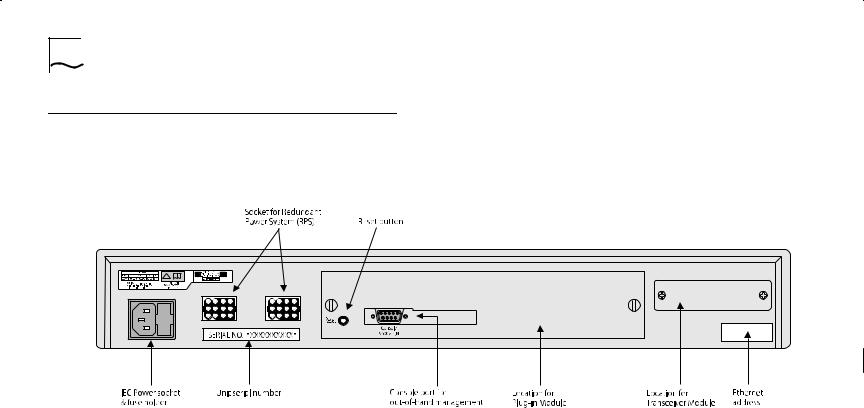
1-12 CHAPTER 1: GETTING STARTED
Unit Overview — Rear
Figure 1-5 Switch 1000 rear view

Power Socket
The Switch 1000 automatically adjusts to the supply voltage. The fuse is suitable for both 110V A.C. and 220–240V A.C. operation. For information on replacing fuses, refer to Appendix A.
Unit Serial Number
You may need this serial number for fault reporting purposes.
Redundant Power System Socket
Use one of these sockets to connect a SuperStack II Redundant Power System (RPS) to the unit. You can use either socket. Refer to “Connecting a Redundant Power System (RPS)” on page 2-6.
Reset Button
Using the reset button simulates a power-off/on cycle. This has the same effect as carrying out a reset via the VT100 interface; refer to “Resetting the Switch” on page 4-27.
Console Port
Connect a terminal to the console port to carry out remote or local out-of-band configuration and management. The console port is set to auto-baud, 8 data bits, no parity, and 1 stop bit.
Unit Overview — Rear |
1-13 |
Plug-in Module Slot
Use this slot to install a Plug-in Module. The Module can be used to provide a high speed link to the rest of your network. 3Com provides a range of Plug-in Modules; contact your supplier for availability.
When a Plug-in Module is not installed, ensure the blanking plate is secured in place.
Transceiver Module Slot
Use this slot to connect a Transceiver Module and provide a 10Mbps link to the rest of the network. Port 1 is automatically switched from the front 10BASE-T port to the Transceiver Module port when a Module is installed. 3Com provides a range of Transceiver Modules; contact your supplier for availability.
When a Transceiver Module is not installed, ensure the blanking plate is secured in place.
Ethernet Address
This label shows the unique Ethernet (or MAC) address assigned to the unit.

1-14 CHAPTER 1: GETTING STARTED
Unit Defaults
The following table shows the factory defaults for the Switch 1000 features.
Port Status |
Enabled |
Forwarding Mode |
Fast Forward |
Intelligent Flow |
Enabled |
Management |
|
Duplex Mode |
Half duplex on all relevant ports |
Virtual LANs |
All ports use Port VLAN Mode and belong to |
|
the Default VLAN (VLAN 1) |
PACE |
Disabled |
Spanning Tree (STP) |
Disabled |
Power On Self Test |
Normal (Fast Boot) |
(POST) |
|
System Alarm
(broadcast bandwidth used)
System Alarm
(errors per 10,000 packets)
System Alarm (bandwidth used)
System Alarm
(percentage of frames forwarded)
Enabled
■High threshold: 20% — Notify and Blip
■Low threshold: 10% — No action
Enabled
■High threshold: 2% — Notify
■Low threshold: 1% — No action
Enabled
■High threshold: 85% — No action
■Low threshold: 50% — No action
Enabled
■High threshold: 85% — No action
■Low threshold: 50% — No action
Managing the Switch 1000
The menu-driven interface built into the Switch 1000 is known as the VT100 interface. You can access it using a VT100 terminal, or a PC using terminal emulation software. You can connect the terminal directly to the Switch or through a modem. You can also access the VT100 interface remotely using Telnet running over the TCP/IP protocol.
Remote management is also possible using a Network Manager from 3Com’s Transcend® product range. The management protocol is SNMP (Simple Network Management Protocol) and any SNMP-based management facility can manage the unit if the Management Information Base (MIB) is installed correctly in the management workstation. The Switch 1000 supports SNMP over both IP and IPX protocols.

Quick Start For SNMP Users
This section describes how to get started if you want to use an SNMP Network Manager to manage the Switch. It assumes you are already familiar with SNMP management.
■If you are using IP and you have a BOOTP server set up correctly on your network, the IP address for the Switch is detected automatically and you can start managing the Switch without any further configuration.
■If you are using the IPX protocol, the Switch 1000 is allocated an IPX address automatically. You can start the SNMP Network Manager and begin managing the Switch.
■If you are using IP without a BOOTP server, you must enter the IP address of the Switch before the SNMP Network Manager can communicate with the device. To do this, refer to “Entering an IP Address for the Switch” below.
If you need more information about IP and IPX, refer to “Managing Over The Network” on page 3-2.
Entering an IP Address for the Switch
1Connect a terminal to the console port of the Switch 1000, refer to “Connecting a VT100 Terminal” on page 2-7. The terminal should be configured to 9600 line speed (baud rate), 8 data bits, no parity, and 1 stop bit.
2Press [Return] one or more times until the Main Banner screen appears.
Quick Start For SNMP Users |
1-15 |
3At the Main Banner screen, press [Return] to display the Logon screen. Log on using the default user name admin (no password is required). Select OK.
4The Main Menu is displayed. From this menu, select the MANAGEMENT SETUP option. The Switch Management Setup screen is displayed.
5On the Management Setup screen, fill in the following fields:
■Device IP Address
■Device SubNet Mask (if necessary)
■Default Router (if necessary)
For further information on the Management Setup screen, refer to “Setting Up the Switch for Management” on page 3-6.
6If you need the Switch 1000 to send SNMP traps to the Network Manager, you may need to set up the address of the Network Manager in the Trap Table. Refer to “Setting Up Traps” on page 4-24.
3Com Network Managers such as Transcend Enterprise Manager for Windows may automatically configure the Switch 1000 to send traps to them.
Please read the documentation supplied with your network management software.
7When you have finished with the Management Setup screen, select OK.

1-16 CHAPTER 1: GETTING STARTED

2 INSTALLATION AND SETUP
Following Safety Information
Before installing or removing any components from the Switch, or carrying out any maintenance procedures, you must read the safety information provided in Appendix A of this guide.
Positioning the Switch 1000
The Switch is suited for use in the office where it can be wall-mounted, mounted in a standard 19-inch equipment rack, or free standing. Alternatively, the unit can be rack-mounted in a wiring closet or equipment room. A wall-mounting / rack-mounting kit, containing two mounting brackets and six screws, is supplied with the Switch.
When deciding where to position the unit, ensure that:
■You are able to meet the configuration rules detailed in the following section.
■The unit is accessible and cables can be connected easily.
■Cabling is away from:
■Sources of electrical noise such as radios, transmitters and broadband amplifiers.
■Power lines and fluorescent lighting fixtures.
■Water or moisture cannot enter the case of the unit.
■Air-flow around the unit and through the vents in the side of the case is not restricted. We recommend that you provide a minimum 25mm (1in.) clearance.
■No objects are placed on top of the unit.
■Units are not stacked more than four high if free-standing.

2-2 CHAPTER 2: INSTALLATION AND SETUP
Configuration Rules for Fast Ethernet
The topology rules for 100Mbps Fast Ethernet are slightly different to those for 10Mbps Ethernet. Figure 2-1 illustrates the key topology rules and provides examples of how they allow for large-scale Fast Ethernet networks.
The key topology rules are:
■Maximum UTP cable length is 100m (328ft) over category 5 cable.
■A 412m (1352ft) fiber run is allowed for connecting switch to switch, or endstation to switch, using half-duplex 100BASE-FX.
■A total network span of 325m (1066ft) is allowed in single-repeater topologies (one hub stack per wiring closet with a fiber run to the collapsed backbone). For example, a 225m (738ft) fiber downlink from a repeater to a router or switch, plus 100m (328ft) UTP run from a repeater out to the endstations.
Configuration Rules with Full Duplex
The Switch provides full duplex support for all its fixed Ethernet and Fast Ethernet ports, and Fast Ethernet Plug-in Module ports. Full duplex allows frames to be transmitted and received simultaneously and, in effect, doubles the potential throughput of a link.
With full duplex, the Ethernet topology rules are the same, but the Fast Ethernet rules are:
■Maximum UTP cable length is 100m (328ft) over category 5 cable
■A 2km (6562ft) fiber run is allowed for connecting switch-to-switch, or endstation-to-switch
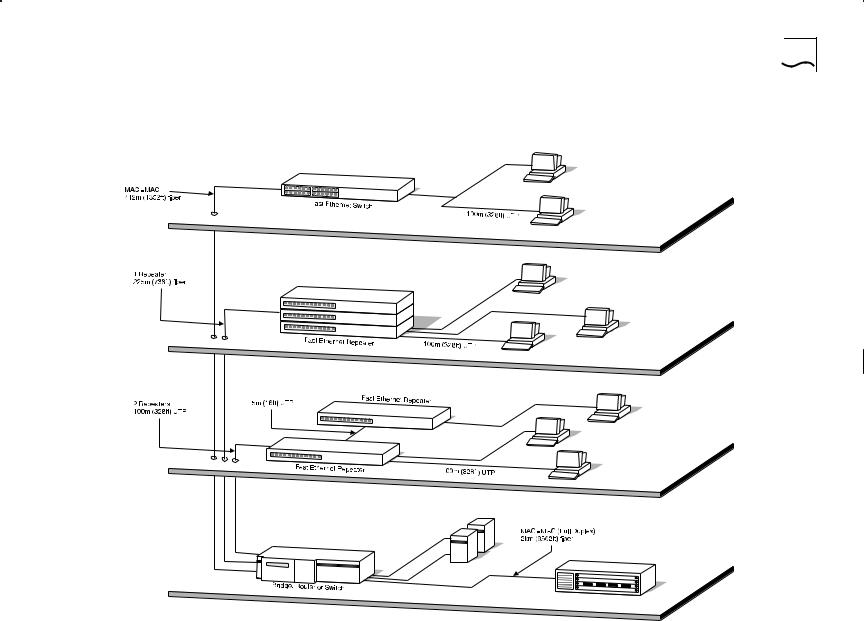
Configuration Rules with Full Duplex |
2-3 |
Figure 2-1 Fast Ethernet configuration rules
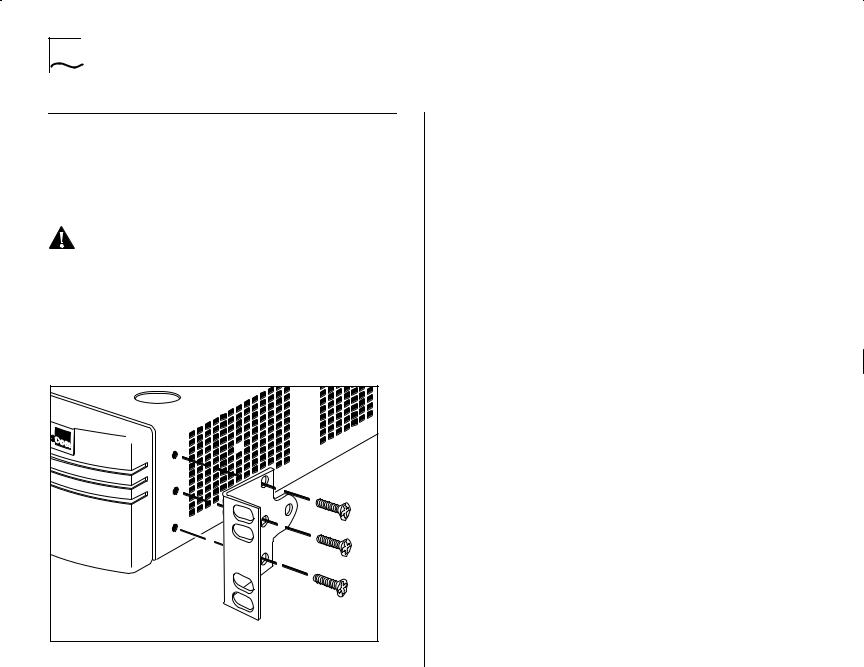
2-4 CHAPTER 2: INSTALLATION AND SETUP
Installing the Switch 1000
Rack Mounting
The Switch is 1.5U high and fits in most standard 19-inch racks.
CAUTION: Disconnect all cables from the Switch before continuing. Remove all self adhesive pads from the underside of the unit, if fitted.
1Place the unit the right way up on a hard flat surface, with the front facing towards you.
2Locate a mounting bracket over the mounting holes on one side of the unit, as shown in Figure 2-2.
Figure 2-2 |
Fitting a bracket for rack mounting |
3Insert the three screws and fully tighten with a suitable screwdriver.
4Repeat steps 2 and 3 for the other side of the unit.
5Insert the unit into the 19-inch rack and secure with suitable screws (not provided). Ensure that ventilation holes are not obstructed.
6Connect network cabling.
Stacking the Switch and Other Units
If the units are free standing, up to four units can be placed on top of one another. If mixing a variety of SuperStack II Switch and Hub units, the smaller units must be positioned at the top.
The Switch is supplied with four self-adhesive rubber pads. Apply the pads to the underside of the unit, stick one in the marked area at each corner of the unit. Place the units on top of each other, ensuring that the pads of the upper unit line up with the recesses of the lower unit.
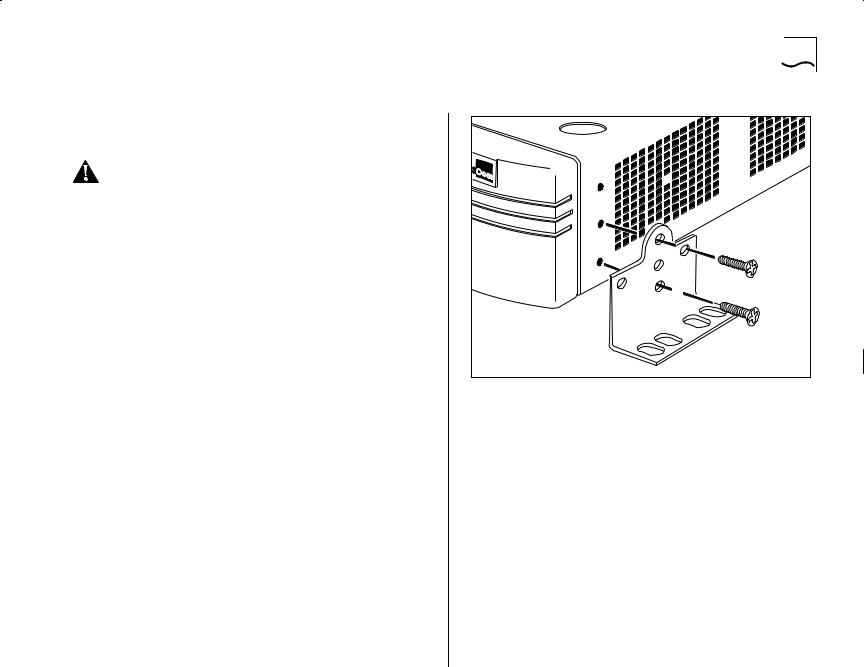
Wall Mounting
A single Switch can be wall-mounted.
CAUTION: Disconnect any cables from the unit before continuing. Remove self-adhesive pads from the underside of the unit if they have been previously fitted.
1Place the Switch the right way up on a hard flat surface, with the front facing towards you.
2Locate a mounting bracket over the mounting holes on one side of the unit, as shown in Figure 2-3.
3Insert the two screws and tighten with a suitable screwdriver.
4Repeat for the other side of the unit.
5Ensure that the wall you are going to use is smooth, flat, dry and sturdy. Attach a piece of plywood, approximately 305mm x 510mm x 12mm (12in. x 20in. x 0.5in.) securely to the wall if necessary, and mount the Switch as follows:
a Position the base of the unit against the wall (or plywood) ensuring that the ventilation holes face sidewards. Mark on the wall the position of the screw holes in both wall brackets. Drill the four holes.
b Using suitable fixings and screws (not provided), attach the Switch unit securely to the wall or plywood.
c Connect network cabling.
Installing the Switch 1000 |
2-5 |
Figure 2-3 Fitting a bracket for wall mounting

2-6 CHAPTER 2: INSTALLATION AND SETUP
Powering-up the Switch
1Connect the power cord to the IEC socket on the rear of the Switch, and to your mains socket.
The Switch has no ON/OFF switch; the only method of connecting or disconnecting mains power is through the power cord.
2The Switch enters a Power On Self Test (POST). The time taken for the test to complete is dependent on the type of POST configured (refer to “Switch Management Setup” on page 3-9 for details of how to configure the type of POST). For a new Switch that is being installed for the first time, power-up takes approximately 13 seconds.
3Check the status LEDs to ensure the Switch is operating correctly (refer to “LEDs” on page 1-11).
Connecting a Redundant Power System (RPS)
You can connect a SuperStack® II Redundant Power System (RPS) to the Switch.
At +5V, the current requirement for the Switch is 4.8A, including any Transceiver Module that might be fitted, but excluding a Plug-in Module. Check the documentation supplied with your Plug-in Module for power consumption figures.
For most configurations, you need only one Superstack II RPS output, and this can be connected to either of the two sockets on the rear of the unit.
If the current consumption of the Switch plus any Plug-in Module exceeds the capability of the RPS (8.5A), you need a SuperStack II Advanced RPS with one Advanced RPS 100W Module.
If the RPS is used incorrectly, its Output Fault LED lights yellow.
You should check the documentation supplied with the RPS or Advanced RPS to see if the outputs can be used in parallel.
